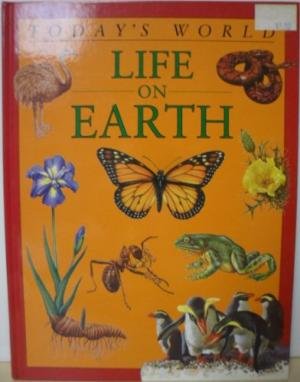-
Life on Earth: Ocean
Heather Alexander, Andres Lozano
Board book (Wide Eyed Editions, March 22, 2018)How do fish breathe? Why is the ocean salty? Why is a whale not a fish? Find out the answers to these and many more questions in this brilliant interactive lift-the-flap fact book. Embark on an epic journey under the sea looking for fish and other ocean creatures beneath the waves, learn what shells are for, find out which sea creatures are the most dangerous, and take a closer look at a coral reef. This fascinating fact-filled book is the perfect introduction to life under the sea. I
I
-
Life on Earth
Linda Gamlin
Hardcover (Franklin Watts Ltd, Aug. 15, 1988)BRAND NEW
-
Life on Earth
Susan Mayes
Hardcover (Usborne Pub Ltd, April 1, 2002)Hardbound with Colorful Cover V
V
-
Early Life on Earth
Michael Bright
Library Binding (Powerkids Pr, Aug. 15, 2017)How and where did life begin on Earth? What makes Earth capable of sustaining living creatures? This information-rich book takes readers billions of years into the past to understand the earliest life-forms on Earth. Theyll delve deeply into essential science topics such as geological time, evolution, and animal classification. Intricate illustrations and 3-D images transport readers to a time before humans walked the earth. Engaging fact boxes highlight fascinating information and encourage curiosity. Avid and reluctant readers alike will be transfixed by the marvels of our planets earliest life-forms, making this book a valuable addition to any library. M
M
-
LIFE ON EARTH
Donald M. Silver
Paperback (Random House Books for Young Readers, Sept. 12, 1983)A basic explanation of how plants and animals function and relate to each other. X
X
-
Life on Earth
Susan Mayes, Sophy Tahta
Paperback (Usborne Publishing Ltd, Feb. 24, 1995)None
-
LIFE ON EARTH
Donald M. Silver
Hardcover (Random House Books for Young Readers, Sept. 12, 1983)A basic explanation of how plants and animals function and relate to each other. X
X
-
Life on Earth
Jon Richards, Ed Simkins
Paperback (Gareth Stevens Pub, Jan. 15, 2018)In order to survive, all living things on Earth must adapt to their environment. They all have certain senses that help them hunt for prey or ways they protect themselves. It's impossible to learn all of it, but through the infographics in this book, readers are sure to understand a great deal. With colorful diagrams and succinct text, each chapter covers a different facet of life on Earth, including how plants protect themselves, cold adaptations, and the carbon cycle. "Try This" boxes throughout the book engage readers by suggesting activities and asking questions related to the text. O
O
-
Early Life on Earth
Michael Bright
Paperback (Powerkids Pr, Aug. 15, 2017)How and where did life begin on Earth? What makes Earth capable of sustaining living creatures? This information-rich book takes readers billions of years into the past to understand the earliest life-forms on Earth. Theyll delve deeply into essential science topics such as geological time, evolution, and animal classification. Intricate illustrations and 3-D images transport readers to a time before humans walked the earth. Engaging fact boxes highlight fascinating information and encourage curiosity. Avid and reluctant readers alike will be transfixed by the marvels of our planets earliest life-forms, making this book a valuable addition to any library. M
M
-
Life on Earth
Stephen Holmes, Jonathan Lambert
Hardcover (B.E.S. Publishing, Sept. 8, 2002)Millions of years ago, life on Earth began in the oceans, then moved to the land, eventually producing all the animals and people we recognize today. This pop-up picture book tells younger children how life developed. It uses words kids can readily understand and dramatizes the concepts with delightful full-color illustrations that literally spring up off the page. Here's a fun introduction that will teach younger children about life forms. Each of the book's five pop-up illustrations opens from a two-page spread that has an added gatefold page attached. Each time young readers open the extra gatefold, they activate a clever pop-up creature. Illustrations include a sea monster that opens and closes its jaws, a prehistoric bug that flaps many wings, an ancient reptile that raises its neck and head, a tiny prehistoric mammal that scampers over a nest of dinosaur eggs, and a modern human baby who cheerfully pops up from a page of his own. (Ages: 2-5) I
I
-
Life on Earth
Pennie Stoyles, Peter Pentland
Library Binding (Benchmark Books, Sept. 1, 2011)"Introduces young readers to the many different types of energy used by animals, plants, fungi, and bacteria, including light, sound, heat, and electrical energies"-- T
T
-
Life on Earth
Eduardo Banquieri
Library Binding (Chelsea Clubhouse, Jan. 1, 2005)Give readers an up-close look at planet Earth and its solar system. From the origin of the universe to the international space station, T
T